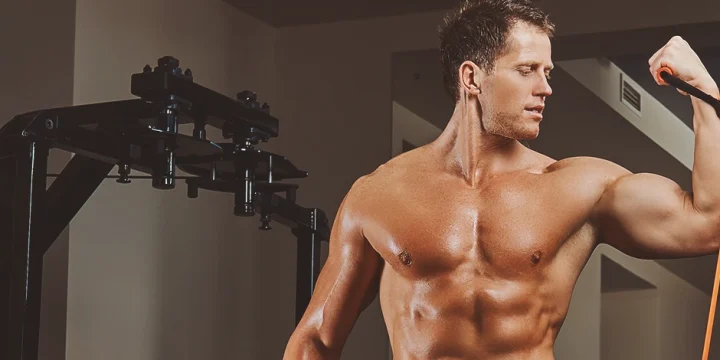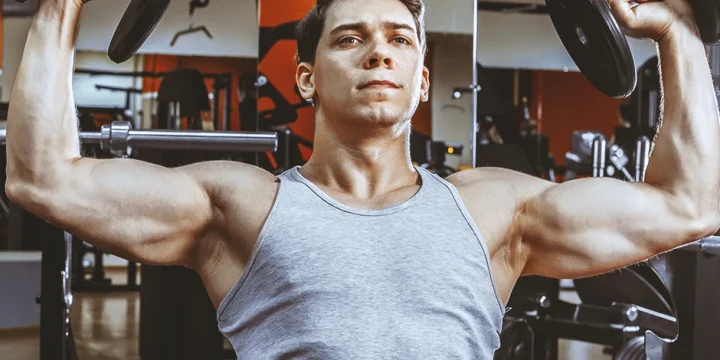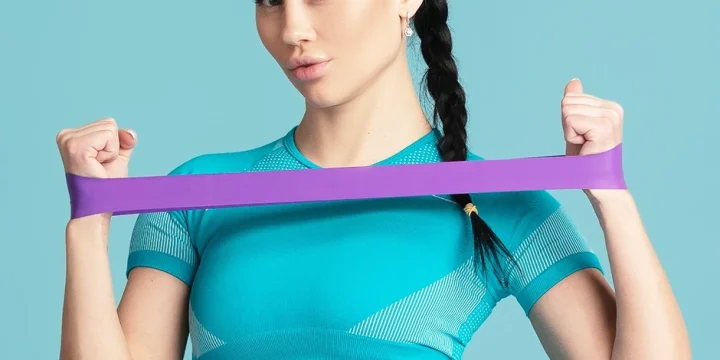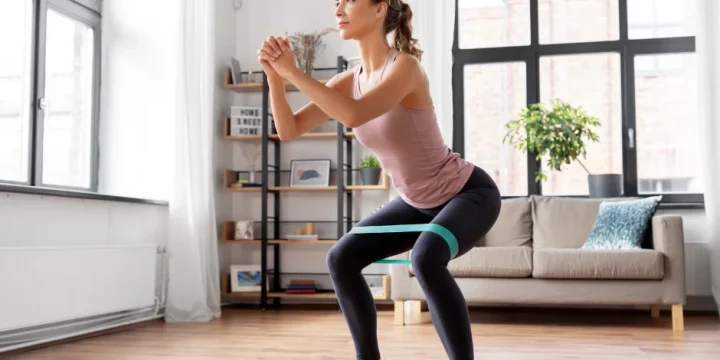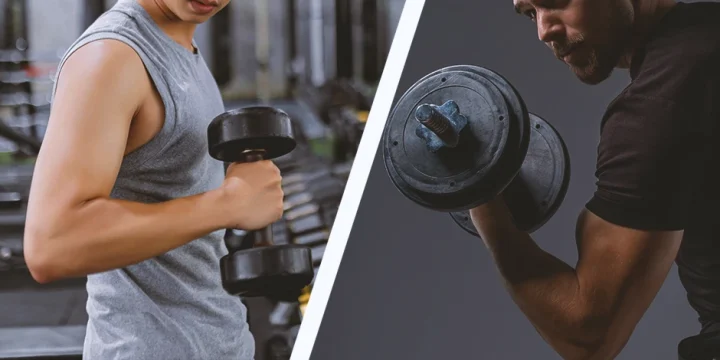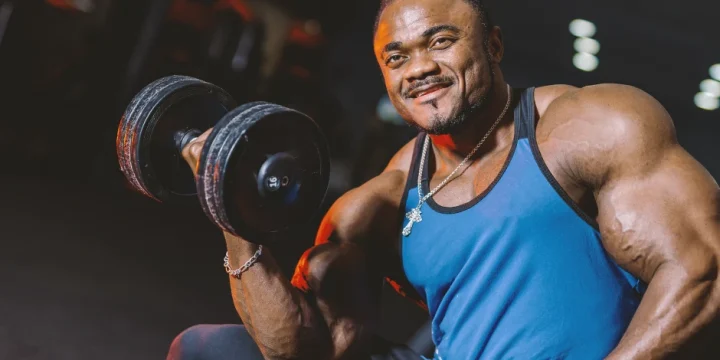Strong and defined biceps have always symbolized power and prowess.
But countless readers have asked me whether it’s possible to achieve that without a gym membership or heavy equipment.
So, after hours of rigorous research and observing clients’ results, we’ve curated a list of the best resistance band bicep exercises that proved to be the most effective.
Here are our top picks for resistance band bicep exercises.
Quick Summary
- Biceps exercises with resistance bands include movements like hammer curls, concentration curls, and preacher curls.
- Resistance bands are an effective tool for building and strengthening the biceps muscles at home or on the go.
- According to research in the Journal of Human Kinetics, selecting the appropriate resistance level in band exercises is crucial for safety and effectiveness.
- Personally, I find resistance band workouts to be a convenient and versatile option for enhancing bicep strength, especially for those with limited access to traditional gym equipment.
Top 5 Resistance Band Bicep Exercises
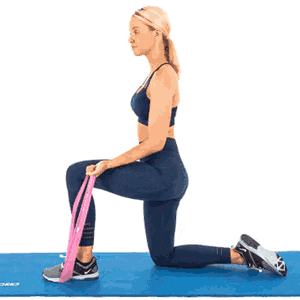
Here are our top five resistance band bicep exercises.
1. Single-Arm Resistance Band Biceps Curls
The single-arm resistance band bicep curl is a fantastic exercise to pump up your muscles and improve your upper-body strength.
This exercise uses a resistance band to create tension against the bicep muscles.
As you perform the curling motion, the resistance bands increase their tensile strength and challenge your muscle growth, allowing for maximum results.
Here’s how to do it:
- Stand with your feet shoulder-width apart and the band under your feet.
- Grasp one end of the band with one hand, and keep the arm extended down.
- Curl the hand up towards the shoulder, keeping the upper arm stationary.
- Pause briefly, then lower the band back down.
- Repeat for the desired number of reps; switch arms and repeat.
2. Single-Arm Hammer Curls
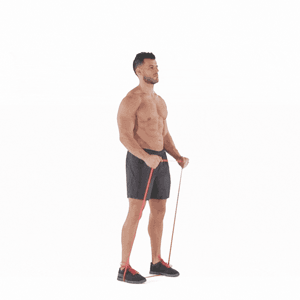
The single-arm hammer curl involves a neutral hand position, executing a bicep curl while keeping the palms inward.
When done using resistance bands, this exercise is highly efficient in building muscle and strength in the biceps and forearm muscles.
Compared to other grips, the neutral grip in hammer curls is less stressful on the wrists.
To perform the hammer curl:
- Step on the resistance band with both feet shoulder-width apart.
- Grab the band with both hands and hold it with an overhand grip, palms facing your body.
- Stand up straight, keeping your elbows close to your sides.
- Slowly raise the band by bending your elbows and bringing your hands towards your shoulders.
- Hold the band at the top for a second, squeezing your forearms.
- Slowly lower the band to the starting position.
 3. Concentration Curls
3. Concentration Curls
From my personal training sessions, I've found concentration curls with resistance bands to be incredibly effective in isolating the biceps, offering my clients noticeable improvements in muscle tone.
Using a resistance band, you can provide continuous tension on the biceps throughout the entire range of motion.
To perform this exercise, follow these steps:
- Sit with your feet flat and your band under them.
- Hold the resistance bands and rest your elbow on your thigh with the arm extended and the band taut.
- Curl the band towards the shoulder, keeping the arm steady.
- Squeeze the biceps at the top and lower the band to the starting position.
- Alternate arms and repeat the desired reps.
4. Preacher Curls
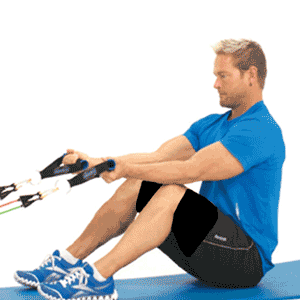
Preacher curls are typically performed using a preacher curl bench, which supports the arms and isolates the biceps.
This exercise is great for isolating the biceps brachii muscle, which runs along the front of the arm and can help to improve overall arm strength and size.
To perform preacher curls with resistance bands:
- Secure one end of the band to a sturdy object.
- Grasp the other end with an underhand grip and rest your arms on a preacher bench or stability ball.
- Tuck your elbows in and keep your shoulders back.
- Curl the band up towards your shoulders.
- Squeeze your biceps at the top of the movement, then lower the band back down slowly.
- Repeat for the desired reps.
 5. Reverse Bicep Curl
5. Reverse Bicep Curl
In my experience, reverse bicep curls with resistance bands not only stretch the biceps but also add significant resistance to the forearms, which many of my clients have found beneficial for overall arm strength.
To perform the reverse curls with a resistance band, follow these steps:
- Step on the resistance band with both feet shoulder-width apart.
- Grab the band with an overhand grip, palms facing down.
- Stand up straight, keeping your elbows close to your sides.
- Raise the band by bending your elbows towards your shoulders.
- Hold the band at the top, and squeeze your biceps and forearms.
- Slowly lower the band back and repeat for desired reps.
“Strength training resistance bands workout focuses on creating lean muscle. Adding a bit of movement and combination exercises helps to increase your heart rate too!”
- Courtney Holland, Exercise Physiologist
Also Read: Crossfit Bicep Workout
Anatomy of the Muscle
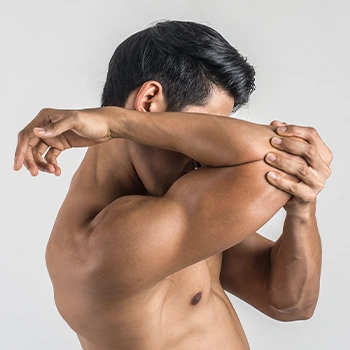
The biceps brachii is a two-headed muscle that runs from the shoulder blade to the elbow joint.
The long head bicep and the short head, named for their respective lengths, run along the upper arm bone and work together to flex the elbow and supinate the forearm [1].
The functions of the long head and short head combined are essential for everyday tasks like lifting objects and performing manual labor, as well as more athletic pursuits like throwing, punching, and climbing.
Understanding the anatomy of the bicep, including the long and short heads, allows for focused workouts that enhance both the size and shape of your arms.
How Can You Isolate the Biceps When Training?
To isolate the biceps when training, start with exercises that focus on elbow flexion, the primary function of the biceps.
Then make sure to:
- Use a full range of motion
- Avoid swinging or using momentum to lift the weight
- Keep your elbows tight to your sides
- Focus on squeezing the biceps at the movement’s top
“If you want to be able to lift your kid into a car seat, pick up a heavy bag of groceries or climb a ladder to get onto your roof and clean the gutters, you need to have biceps strength.”
- Jenna Moore, Certified Strength & Conditioning Coach
Tips for Maximizing Resistance Band Bicep Workouts
Based on my coaching experience, I emphasize to my clients that proper use of resistance bands is key to maximizing the effectiveness of their bicep workouts.
Here are some tips to help you take your arm muscle mass game to the next level with resistance band exercises:
- Warm up before biceps exercises to stretch and activate your muscles.
- Focus on proper form, avoid momentum, and squeeze your biceps.
- Vary your banded bicep exercises to avoid plateauing.
- Recover with good nutrition and hydration.
- Rest adequately for muscle repair and growth.
Related Articles:
Choosing the Right Product

Choosing the right resistance bands for biceps exercises is crucial for achieving maximum gains in a biceps workout.
Here are a few things to consider when selecting resistance bands:
- Resistance level: Go for resistance bands with enough tension to challenge your muscles but not compromise form. Utilizing their low-impact nature makes them ideal for gradually strengthening the biceps and surrounding muscles, reducing the risk of strain and even promoting faster recovery from arm-related injuries.
- Length: Choose resistance bands that are long enough to allow a full range of motion. Short resistance bands can restrict movement and limit results.
- Quality: Invest in high-quality resistance bands that won’t break or snap during use. Look for bands made from durable materials with reinforced stitching and secure handles.
- Personal preference: Ultimately, the best resistance bands for you are the ones that feel comfortable and natural to use. Experiment with different styles and resistance levels until you find the best one for your body and goals.
Safety Precautions
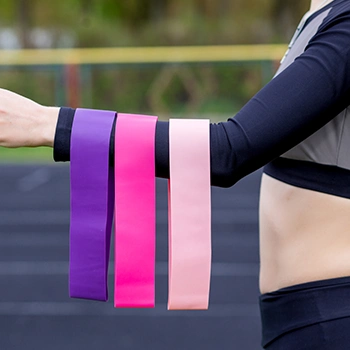
Resistance band biceps exercises are generally safe with proper technique and caution.
However, according to research published in the Journal of Human Kinetics, choosing the right resistance level is important, as is using the resistance bands on a stable surface and avoiding overstretching them [2].
Additionally, always stop immediately if you feel pain or discomfort in your arm muscles, and consult with a healthcare professional if you have any concerns.
FAQs
Can I Build Biceps With Resistance Bands?
Yes, you can build biceps with resistance bands. Try various biceps exercises, like curls, rows, and pushdowns, to target your biceps from different angles.
Are Resistance Bands Bicep Curls Effective?
Yes, resistance bands Bicep curls are effective for building bicep strength and size as long as you use proper form and progress to more challenging resistance bands, as stated in the study from the Sage Open Medicine Journal [3].
What Is the King of All Bicep Exercises?
The standing barbell curl is the king of all bicep exercises. It allows you to lift heavy weights and work both biceps simultaneously with a full range of motion.
References:
- https://www.ncbi.nlm.nih.gov/books/NBK519538/
- https://www.ncbi.nlm.nih.gov/pmc/articles/PMC8884877/
- https://www.ncbi.nlm.nih.gov/pmc/articles/PMC6383082/
About The Author
You May Also Like
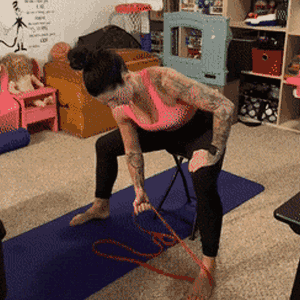 3. Concentration Curls
3. Concentration Curls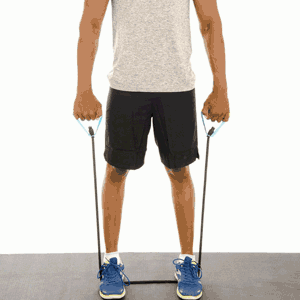 5. Reverse Bicep Curl
5. Reverse Bicep Curl